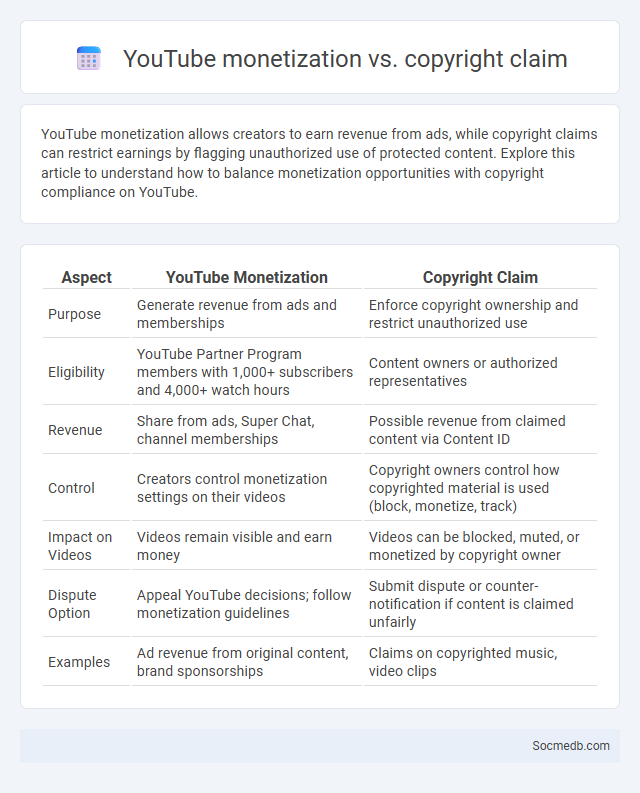
Photo illustration: YouTube monetization vs Copyright claim
YouTube monetization allows creators to earn revenue from ads, while copyright claims can restrict earnings by flagging unauthorized use of protected content. Explore this article to understand how to balance monetization opportunities with copyright compliance on YouTube.
Table of Comparison
| Aspect | YouTube Monetization | Copyright Claim |
|---|---|---|
| Purpose | Generate revenue from ads and memberships | Enforce copyright ownership and restrict unauthorized use |
| Eligibility | YouTube Partner Program members with 1,000+ subscribers and 4,000+ watch hours | Content owners or authorized representatives |
| Revenue | Share from ads, Super Chat, channel memberships | Possible revenue from claimed content via Content ID |
| Control | Creators control monetization settings on their videos | Copyright owners control how copyrighted material is used (block, monetize, track) |
| Impact on Videos | Videos remain visible and earn money | Videos can be blocked, muted, or monetized by copyright owner |
| Dispute Option | Appeal YouTube decisions; follow monetization guidelines | Submit dispute or counter-notification if content is claimed unfairly |
| Examples | Ad revenue from original content, brand sponsorships | Claims on copyrighted music, video clips |
Introduction to YouTube Monetization
YouTube monetization allows content creators to earn revenue by displaying ads, promoting channel memberships, and enabling Super Chat during live streams. By joining the YouTube Partner Program, you gain access to tools that track earnings and optimize your content for better engagement and higher ad revenue. Understanding YouTube's eligibility criteria, including minimum subscriber count and watch hours, is essential for maximizing your income potential.
Understanding Copyright Claims on YouTube
Understanding copyright claims on YouTube involves recognizing how automated Content ID systems detect copyrighted material in videos. When a claim is made, the copyright owner can monetize, block, or track the video's viewership data. Creators should review the claim details carefully and, if necessary, submit a dispute following YouTube's guidelines to avoid strikes or monetization loss.
What is Limited Monetization?
Limited monetization on social media refers to restrictions placed on content that reduces or disables revenue generation from ads or brand partnerships. These limitations often apply to videos or posts containing sensitive topics, copyright issues, or violating platform guidelines, leading to decreased earnings for creators. Platforms like YouTube and Facebook use automated systems to enforce limited monetization, impacting influencer income and content visibility.
Key Differences Between Monetization, Copyright Claims, and Limited Monetization
Monetization on social media allows you to earn revenue through ads or subscriptions on your original content, while copyright claims result from using copyrighted material without permission, potentially restricting your video's reach or monetization. Limited monetization occurs when content contains elements like copyrighted music or potentially advertiser-unfriendly material, reducing ad earnings but still allowing some revenue generation. Understanding these distinctions helps you manage your digital content rights effectively and maximize your social media income.
How Copyright Claims Affect Channel Revenue
Copyright claims on social media directly impact Your channel revenue by restricting monetization opportunities and diverting earnings to the original content owners. These claims can trigger demonetization, ad revenue sharing, or removal of videos, significantly reducing Your income stream. Ensuring Your content is original or properly licensed is essential for maintaining full revenue potential on platforms like YouTube and Facebook.
Reasons for Receiving Limited Monetization
Limited monetization on social media often stems from violations of platform policies, such as copyright infringement, inappropriate content, or lack of original material. Insufficient audience engagement, including low views, likes, or comments, can also restrict earning potential. Furthermore, failure to meet platform-specific eligibility criteria like follower thresholds or content frequency impacts monetization access.
Strategies to Avoid Copyright Claims
Implement clear content creation guidelines to ensure your social media posts respect intellectual property laws and avoid unauthorized use of copyrighted material. Utilize royalty-free or licensed images, music, and videos to protect Your account from potential copyright claims. Regularly monitor and promptly address any copyright notices to maintain compliance and safeguard Your online presence.
Maximizing Earnings with YouTube Monetization
YouTube monetization offers creators multiple revenue streams including ad revenue, channel memberships, and Super Chat during live streams, maximizing earnings potential. Utilizing SEO strategies such as keyword optimization in titles, descriptions, and tags significantly boosts video visibility and subscriber growth. Consistent content upload schedules combined with audience engagement analytics enable creators to refine their approach and increase overall income.
Resolving Disputes: Copyright and Monetization Issues
Resolving disputes related to copyright and monetization on social media involves understanding platform-specific policies and implementing robust content identification systems like Content ID. Effective resolution requires clear guidelines on intellectual property rights, automated detection of unauthorized use, and transparent monetization frameworks to protect creators and advertisers. Legal mechanisms and collaborative tools empower users to address claims swiftly, ensuring fair revenue distribution and minimizing infringement risks.
Best Practices for Safe and Profitable Content Creation
Creating content on social media requires adherence to best practices such as consistent audience engagement, use of high-quality visuals, and clear calls to action to boost profitability. Prioritizing data privacy and transparency ensures safe content sharing, while leveraging analytics tools optimizes reach and monetization strategies. Compliance with platform guidelines and authenticity in messaging enhances trust and sustainable growth for creators.
 socmedb.com
socmedb.com